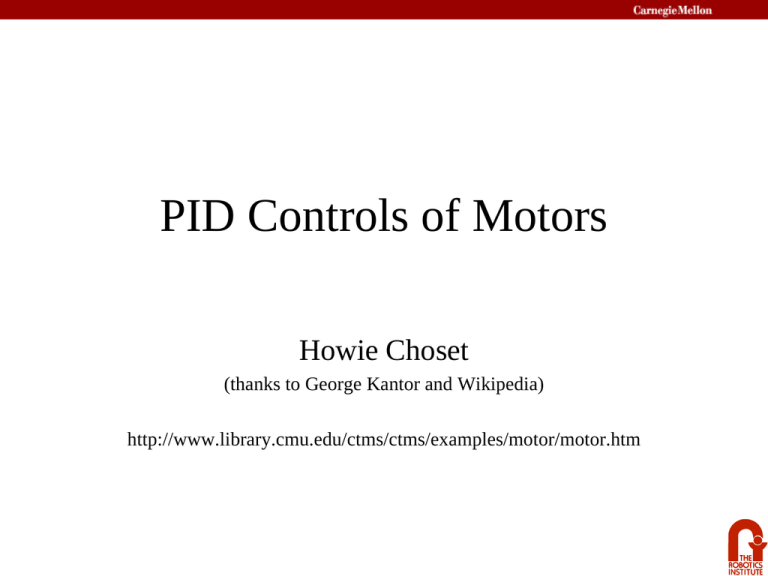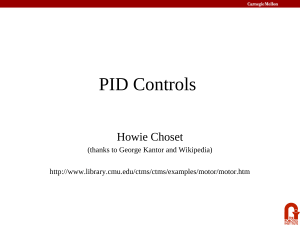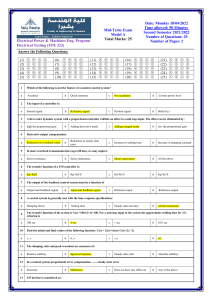PID Controls of Motors Howie Choset (thanks to George Kantor and Wikipedia)
advertisement

PID Controls of Motors Howie Choset (thanks to George Kantor and Wikipedia) http://www.library.cmu.edu/ctms/ctms/examples/motor/motor.htm Overview • Mass-Spring-Damper System • Second order ODE – Definition – Vary parameters – Forcing functions • Different feedback meaning – Proportional – Derivative • • • • • Control for Error – block diagram Integral Control Different Affects of Varying PID Feed Forward Term Vehicle Controls Mass Spring Standard Form of DEQ Natural (undamped) frequency (rads/sec) Damping ratio (unitless) Vary Natural Frequency Mass Spring Damper Standard Form of DEQ Natural (undamped) frequency (rads/sec) Damping ratio (unitless) Let Solutions/Responses Under-damped (0 < ζ < 1) Let Solutions/Responses Under-damped (0 < ζ < 1) Let Solutions/Responses Under-damped (0 < ζ < 1) decay Oscillation, damped natural frequency Let Step Response , As time goes on, x(t) goes to 1 PID Feedback -Kx ( + K) x = 0 Proportional Feedback plant Set desired position to zero Note that the oscillation dies out at approximately the same rate but has higher frequency. This can be thought of as “stiffening the spring”. Proportional/Damping plant We can increase the damping (i.e., increase the rate at which the oscillation dies out) Increasing damping slows everything down (note deriv is an approx and turning the gain high, can cause problems because in a sense it amplifies nois PD works well if desired point is an equilibrium of system, which makes sense because when you are at target, PD does not exert force Non-zero desired PD Xd = 1.6 Settle time same Steady state error! At set point, applying no force so end up settling at equilibrium that balances force due to error and force due to spring (damper goes away in steady state because depends on derivative). Crank up P gain, steady state error gets smaller, but that causes overshoot, oscillations, etc which you don’t want PID Control plant System does its dynamic thing and then gradually integrates to correct for steady state error As increase I gain, gets faster, good response Integral gets so bad, it starts to interfere with other dynamics, lead to unintended motions which could lead to instability Winding of motor Review of Motor Model •electric inductance (L) = [H] (VL = L di/dt) * input (V): Source Voltage * output (theta): position of shaft * The rotor and shaft are assumed to be rigid • moment of inertia of the rotor (J) [kg.m^2/s^2] * damping ratio of the mechanical system (b) [Nms] * electromotive force constant •Ke is volt (electromotive force) per radians per second (V/ rad/sec) • torque constance •Kt is torque amp (Nm/Amp) * electric resistance (R) = [ohm] Review of Motor Model Torque is proportional to current (Lenz’s Law) Back emf is proportional to motor speed (Faraday’s Law) Mechanical Equation of Motion Jθ + bθ = Ki Electrical Equation of Motion di L + Ri = V − Kθ dt s( Js + b ) Θ( s ) = KI( s ) (Ls + R)I( s ) = V − KsΘ( s ) sθ K = V ( Js + b )( Ls + R ) + K 2 + - + Assume (K=Ke=Kt) - Solve for diff eq in w dot Closed Loop Controller Give it a velocity command and get a velocity output Ref + error - Controller Controller Evaluation Steady State Error Rise Time (to get to ~90%) Overshoot Settling Time (Ring) (time to steady state) Stability voltage Plant θ Closed Loop Response (Proportional Feedback) Proportional Control K p Easy to implement Input/Output units agree Improved rise time Steady State Error (true) ➡P: ➢Rise Time vs. ➡ Overshoot* ➡P: ➢Rise Time vs. ➢ Settling time* ➡P: ➢Steady state error vs. other problems R + error - Voltage = Kp error Controller voltage Plant θ *In some other systems, not mass-spring Closed Loop Response (PI Feedback) Proportional/Integral Control 1 K p + KI No Steady State Error s Bigger Overshoot and Settling Saturate counters/op-amps ➡P: ➢Rise Time vs. ➡ Overshoot ➡P: ➢Rise Time vs. ➢ Settling time ➡I: ➢Steady State Error vs. ➡Overshoot Ref + error - 1 voltage K p + KI s Voltage = (Kp+1/s Ki) error Plant θ Closed Loop Response (PID Feedback) Proportional/Integral/Differential Quick response Reduced Overshoot 1 K p + K I + sK D s Sensitive to high frequency noise Hard to tune ➡P: ➢Rise Time vs. ➡ Overshoot ➡P: ➢Rise Time vs. ➢ Settling time ➡I: ➢Steady State Error vs. ➡Overshoot ➡D: ➢Overshoot vs. ➡Steady State Error R + error - 1 K p + K I + sK D s Voltage = (Kp+1/s Ki + sKd) error voltage Plant θ Quick and Dirty Tuning • • • • Tune P to get the rise time you want Tune D to get the setting time you want Tune I to get rid of steady state error Repeat • More rigorous methods – Ziegler Nichols, Selftuning, • Scary thing happen when you introduce the I term – Wind up (example with brick wall) – Instability around set point Feed Forward Volt Decouples Damping from PID To compute K b Try different open loop inputs and measure output velocities For each trial i, ui i K b = . , K b = avg K bi Tweak from there. K θi Kb R + error - + volt + Controller Plant θ Follow a straight line with differential drive or at least get to a point Error can be difference in wheel velocities or accrued distances Make both wheels spin the same speed asynchronous – false start wheels can have slight differences (radius, etc) Make sure both wheels spin the same amount and speed false start Assumptions • • • • planar workspace position of robot and goal are known omni-directional robot (we’ll relax this later) control input is velocity: (boldface lie, we’ll relax this later, too) Proportional (P) Control: • • • • the equation above is called a control law kp is called the proportional gain kp is a tunable parameter physically, kp is the stiffness of the spring Proportional-Derivative (PD) control: Fill the world with honey! In direction of arrow • • • • opposite kd is called the derivative gain kp and kd are tunable parameters physically, kd is the damping term all of the stuff about P control still applies Robot Inputs So far we’ve assumed something like But really, we control the velocities of the left and right wheels, which can easily be mapped to forward and turning velocities: Nonholonomic Constraints The equations of motion using these controls are: The fact that the robot can’t move sideways is a nonholonomic constraint (we will see this again). The Problem: P or PD control won’t work. No smooth control law will! A Simple Solution: Like a rigid trailor hitch (not driving to point) A Simple Solution (cont.): If we ignore orientation: so we can implement the PD control law as: p p Did not get rid of nh constraint, but moved it to something we don’t care about (theta, angular and linear velocities) - trailor hitch story Line following More complicated control laws – track orientation m1vref = vref + K1 * thetaerror + K2 * offset error m2vref = vref - K1 * thetaerror - K2 * offset error offset Really, there is a sensor Encoders Encoders – Incremental Photodetector Encoder disk LED Photoemitter Encoders - Incremental Encoders - Incremental • Quadrature (resolution enhancing) Where are we? • If we know our encoder values after the motion, do we know where we are? Where are we? • If we know our encoder values after the motion, do we know where we are? • What about error?





